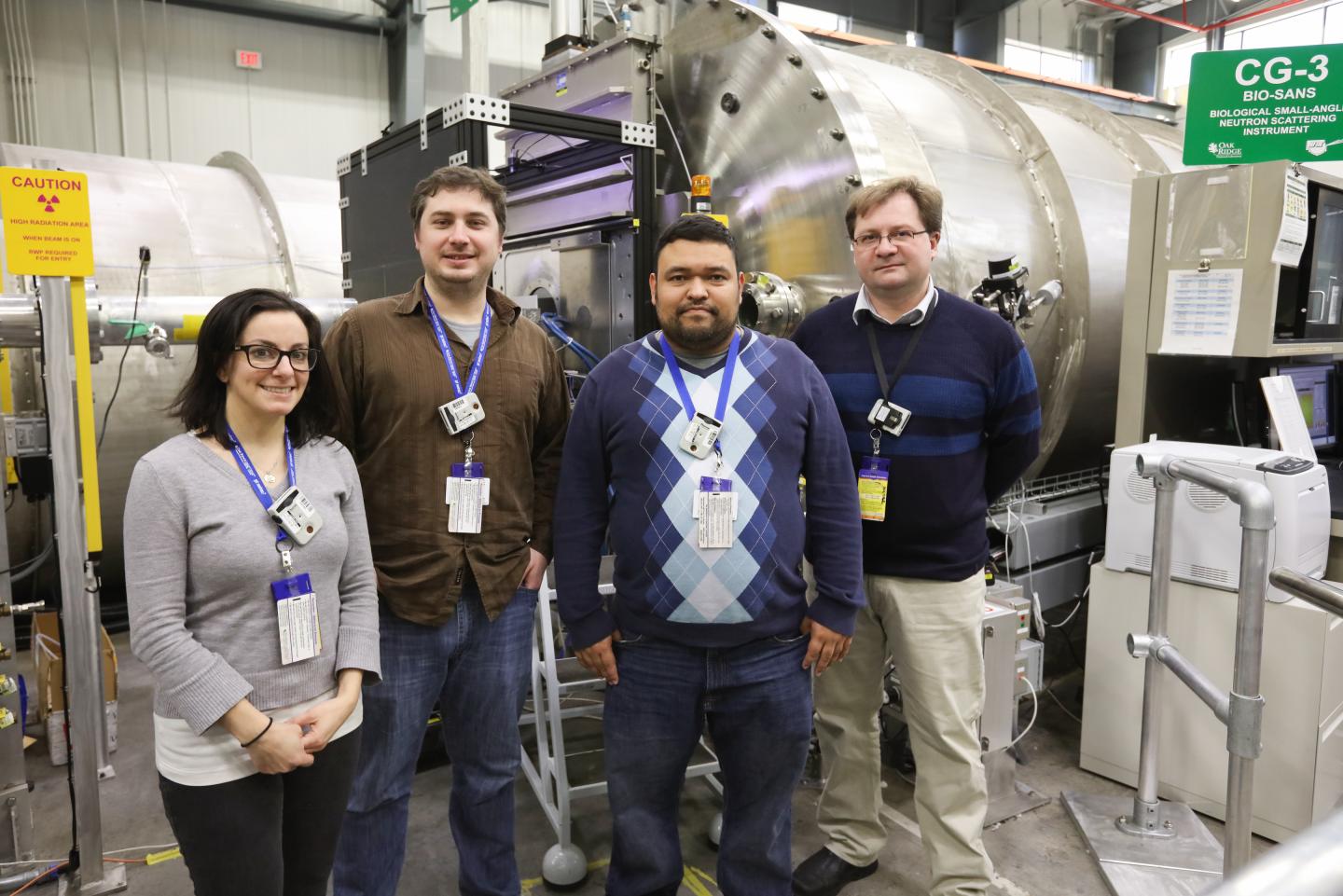
Credit: U.S. Dept. of Energy; ORNL/Genevieve Martin
Scientists from the National Institute of Standards and Technology (NIST) and the University of Maryland are using neutrons at Oak Ridge National Laboratory (ORNL) to capture new information about DNA and RNA molecules and enable more accurate computer simulations of how they interact with everything from proteins to viruses. Resolving the 3D structures of the body’s fundamental genetic materials in solution will play a vital role in drug discovery and development for critical medical treatments.
“A better understanding of both the structure and conformational dynamics of DNA and RNA could help us answer questions about why and how medicines work and help us locate where the key interactions are taking place at the atomic level,” said NIST’s Alexander Grishaev, who led neutron scattering research performed at the High Flux Isotope Reactor (HFIR), a Department of Energy User Facility located at ORNL.
The team used HFIR’s Bio-SANS instrument to perform small- to wide-angle neutron scattering, a technique not previously performed on DNA and RNA samples in solution because of limited experimental capabilities.
“Capturing a wider range of angles for biomolecules in solution using neutron scattering has not been possible until recently,” said Grishaev, “and Oak Ridge is one of the only places you can do this kind of work.”
Extending the capabilities of solution neutron scattering is part of an advancing effort toward a more integrative approach in structural biology that combines crystal studies, solution methods, and other experimental and computational techniques to enhance understanding of DNA and protein structures.
Computer simulations of biomolecules have been well informed by x-ray crystallography. The premier technique uses x-rays to determine the arrangement of atoms in a sample that has been “crystallized” for analysis. To get high-quality data with this technique, samples of biological materials that are typically dilute in solution are concentrated and solidified into crystals with a uniform structure.
X-ray crystallography works especially well for rigid biomolecules with more or less fixed structures, but flexible biomolecules like DNA and RNA that adopt multiple “conformations” or shapes are less suited to crystallization.
Inside living cells, DNA and RNA can move, change shapes, and respond differently to environmental effects such as pH or temperature, alterations that are important to represent but difficult to characterize.
“Crystallization packs the molecules in tightly, which limits their motions and masks some of the structural information we want to see,” said Grishaev.
Several techniques have successfully been applied to DNA and RNA in solution, including solution x-ray scattering and nuclear magnetic resonance (NMR) spectroscopy, both of which yield important data. Yet, significant discrepancies exist between the experimental scattering data and the best available crystal structures of DNA and RNA.
The team turned to neutrons to find out why.
“Neutrons interact with biomolecules differently, so we can use them as an independent source of data for us to either validate or better define the models that we have,” said Maryland’s Roderico Acevedo.
Whereas x-rays work well to define heavy atoms, such as carbon, oxygen, and phosphorus, neutrons are ideal for examining lighter hydrogen atoms that connect DNA strands, for example. Additionally, neutrons offer an advantage in probing biomolecules because they are nondestructive and do not damage them.
Using the Bio-SANS instrument at HFIR, researchers were able to collect structural information in solution not readily obtainable by other experimental techniques.
The experiment required both a high neutron flux and wide-angle detectors to collect higher precision scattering patterns to reveal the atomic-level structures of DNA and RNA in solution.
Using neutrons to collect structural information on biomolecules is no ordinary feat, says Grishaev. Small biomolecular samples in dilute solutions often produce noisy scattering patterns, making the data difficult to analyze.
“HFIR’s Bio-SANS is one of few neutron instruments in the world with the capability to capture small and wide scattering angles simultaneously, combining both global- and local-scale details,” said Bio-SANS instrument scientist Volker Urban.
“We were able to get some of the highest-precision solution neutron scattering data ever collected at wide angles, not just on DNA and RNA, but on biomolecules in general,” said Grishaev.
By adding the new information collected via solution neutron scattering to other data from solution x-ray scattering and NMR spectroscopy, the NIST-Maryland group hopes to get a more comprehensive picture of DNA and RNA structures, as well as to expand avenues for defining molecular structures with neutron-based techniques.
UT-Battelle manages ORNL for the DOE Office of Science. The single largest supporter of basic research in the physical sciences in the United States, the Office of Science is working to address some of the most pressing challenges of our time. For more information, please visit https:/
###
Media Contact
Ashley C Huff
[email protected]
Original Source
https:/




